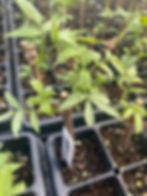
Plants & Supplies
Pre-orders are open for American Elderberry Cuttings that will ship out in January and February of 2026. We have a limited supply, so order yours today so you don't miss out!
Processing & Growing
Supplies & Equipment
Elderberry Destemming Tray & Sanitizing Basket
Destem up to 100 pounds an hour if you've got the gumption! This is designed for hand destemming of American elderberries. The tray fits in the basket and you drop the fresh berry heads on the tray, then gently move back and forth to allow the berries to fall through. Remove the tray and your basket fits in a standard size washing sink. Then you're ready to wash and freeze your freshly harvested elderberries. Click HERE to see our destemming tray and sanitizing basket combo in action.



At River Hills Harvest we designed and use our own TED elderberry destemmers during every harvest season...






Terry's Elderberry Destemmer

Terry's Elderberry Destemmer is the ultimate machine for destemming elderberries quickly and efficiently! Easy to operate and clean. Experience gentle destemming of your berries, keeping all the valuable juice possible during your next harvest.
$10,460 Phone or Email Orders Only
Click the button below to learn more about TED
Click HERE to see an informational video.





